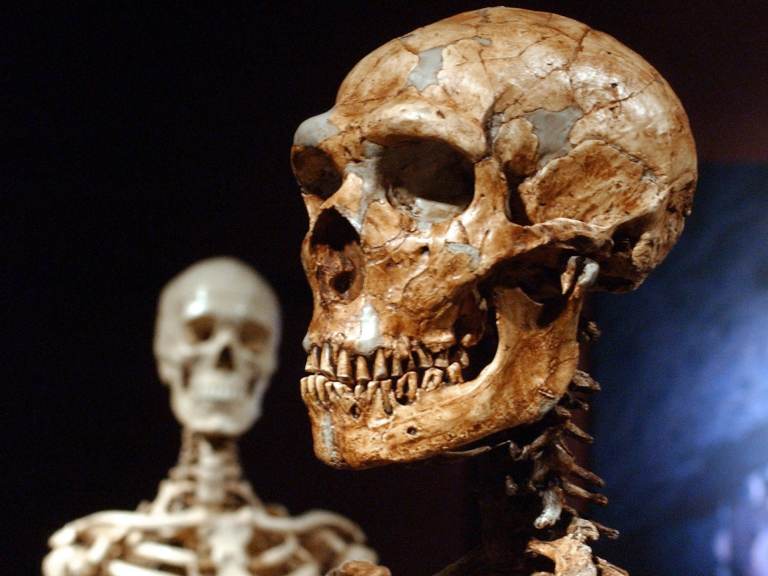Colder climates meant bigger bodies for ancient humans

A reconstructed Neanderthal skeleton (right) and a modern-human version of a skeleton are displayed at the American Museum of Natural History in New York in 2003. A new study confirms that early humans who lived in colder places adapted to have larger bodies. (Frank Franklin II/AP)
Big bodies are good for cold places.
That’s the gist of a foundational rule in ecology that has been around since the mid-1800s: Animals that live in colder places tend to have larger bodies, especially birds and mammals that need to regulate their body temperatures. For example, some of the largest whale and bear species have evolved in the coldest reaches of the planet.
The rule applies broadly to modern humans too. Populations that evolved in colder places generally have bigger bodies.
That’s also true of human ancestors, a new study finds. The research offers conclusive evidence that human body size and climate are historically connected.
In general, our ancient relatives got much larger as they evolved. “Over the last million years, you see that body size changes by about 50% and brain size actually triples, which is a lot,” explains Andrea Manica, an evolutionary ecologist at the University of Cambridge. “And there have been all sorts of theories about what might have underpinned those two big changes in size.”
Manica and a team of paleontologists and climate scientists in Germany and the United Kingdom set out to test one of those theories: that the local climate was driving brain and body growth. They examined about 300 fossils of human ancestors collected in Europe, Asia and Africa, and they used the same basic climate data that scientists use to predict future climate change to estimate instead temperature and precipitation over the last million years.
“We reconstructed climate back in time so we could say what the climate was when that specimen was alive,” Manica says.
The researchers found that human ancestors and Neanderthals living in colder places generally had larger bodies. Past studies suggested this might be true but didn’t assemble such broad evidence. For one thing, past research often relied on rough global estimates of the past climate, whereas this new study estimates what each human ancestor would have experienced in their region.
The new findings are “reasonably convincing,” says Mark Collard, who studies human evolution at Simon Fraser University in Canada and who was not involved in the study. However, he suspects that the new analysis may overstate the relationship between temperature and body size because of uncertainties in both the fossil record and the climate data.
The authors of the new study also found that the rapid increase in human brain size over the last million years was not strongly correlated with climate. “For brains, you need other explanations,” says Manica, perhaps such as diet or social structures.
For decades, scientists who study human evolution have posited that what our ancestors ate — whether it was cooked or raw, whether it included meat or only vegetables — influenced how our brains evolved. It’s also possible that more complex social structures and group communication are linked to brain growth in human ancestors.
“I suspect that social factors such as group size are more likely to influence brain size,” Collard says.
Modern humans need not worry that the new findings about body size and climate will show up in our daily lives.
The Earth is getting steadily hotter because of human-caused climate change. But human body size will not shrink as a result, at least not in the near future.
That’s because it takes many, many generations for humans to evolve. The average human generation is about 30 years, so it would take hundreds or even thousands of years of sustained warming before human body size changed in reaction to global warming. And, even then, the changes would be very slight — about 1 kilogram per 2 degrees of warming, Manica says.
“We’re not going to shrink tomorrow,” he says. “That’s the good news. But climate change is problematic for many other reasons.”
9(MDAzMzI1ODY3MDEyMzkzOTE3NjIxNDg3MQ001))




